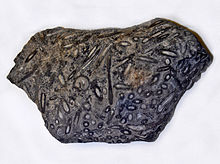
Paleophycology (also once known as paleoalgology) is the subdiscipline of paleobotany that deals with the study and identification of fossil algae and their evolutionary relationships and ecology.
The field is very important in the science of paleolimnology as the algae leave many indicators of fossil ecosystems. Primary and most familiar are both fossil shells from diatoms and biogeochemical traces of algal pigments in lake sediments. These fossils are clues to changes in nutrient availability and ecology of lakes.

Some paleophycologists:
- John P. Smol, a Canadian paleolimnologist
- Stanley Awramik, an American Precambrian paleontologist
- Bruno R. C. Granier, a French stratigrapher and micropaleontologist
- Robert Riding, a British geologist and expert on calcareous algae and stromatolites
References
- "the Free Dictionary".
- Neuendorf, Klaus K. E.; Mehl Jr., James P.; Jackson, Julia A., eds. (2005). Glossary of geology (5th ed.). Alexandria: American Geological Institute. ISBN 9780922152766.
- Smol, John P. (2009). Pollution of Lakes and Rivers a Paleoenvironmental Perspective (2nd ed.). Chichester: John Wiley & Sons. p. 57. ISBN 978-1-4443-0757-3.
- "Use of Algae in Biomonitoring Assessments" (PDF). Centre for Ecological Sciences. Centre for Ecological Sciences, Indian Institute of Science, Bangalore. Retrieved 31 December 2015.
- "Granier's academic page". Archived from the original on 2016-02-20. Retrieved 2015-12-31.
- "Riding's academic page".
This paleobotany-related article is a stub. You can help Misplaced Pages by expanding it. |